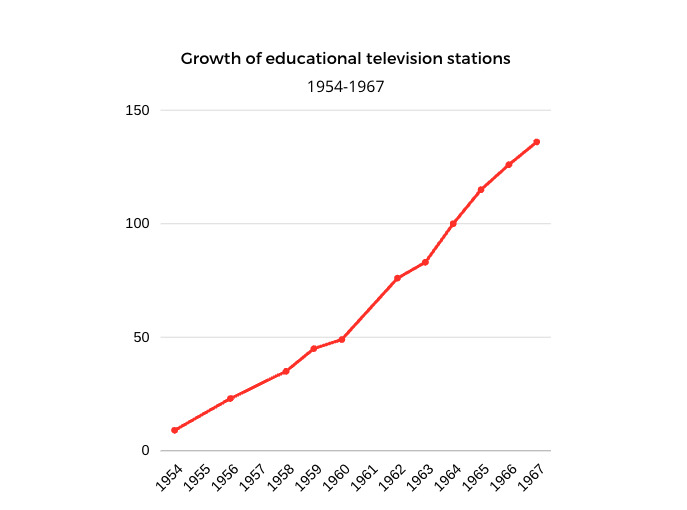What is NET?
Most Americans are likely familiar with the Public Broadcasting Service, or PBS. For many, PBS is their earliest interaction with television through classic children's series such as Sesame Street, Reading Rainbow, and Mister Rogers’ Neighborhood, which have been on the air for several decades. PBS is also known for popular series like American Experience, Antiques Roadshow, Masterpiece Theater, Nova, and This Old House, to name a few.
From 1952 to 1970, however, public television in America was broadcast as National Educational Television, or NET. This era when National Educational Television was broadcasting represents a huge shift in the United States - not only as a pioneering age for television, but socially, culturally, and politically. These programs give us a peek into the living rooms of the midcentury and the increasing importance of documentary, news, and public affairs programming to American audiences.
NET was established via a grant from the Ford Foundation in 1952 with the mission of distributing (and later producing) educational programming. The National Educational Television and Radio Center, as it was called until 1963, initially had no equipment or production staff of its own. Rather, NET aggregated programming produced by member stations and other sources of educational material, such as McGraw-Hill or the BBC, and broadcast them to other member stations. The first non-commercial educational television station was KUHT in Houston - they began broadcasting in May 1953.2 NET followed close behind and officially began broadcasting in 1954.
Initially, there was limited interest in and even resistance to using television as a medium for education. Fritz Jauch explains this attitude in A Brief History of Educational Television in the United States:
“The public remained largely apathetic. Most Americans enthusiastically accepted television as an entertainment medium, but were unaware of or indifferent to its educational potentialities. The intellectuals had not yet begun to take seriously television of any kind. And meanwhile, many of the nation’s school teachers and administrators were skeptical of ETV, and even hostile to it. Some thought it would destroy the teacher-student relationship; others feared it would eliminate the job of the teacher, or reduce him to the role of proctor.”4

Click to watch a 1961 pubic service announcement from NET promoting educational television as a means of self-improvement (from the CLIO Awards collection).
Despite this initial hesitation, the availability of quality instructional material at little or no cost eventually made public television an integral part of the American education - whether the students were receiving a formal education inside a classroom or viewing the programs in their own homes. Viewers indicated that they were drawn to educational programming out of a desire to be more well-informed, intellectually engaged, and culturally connected.5
Around this time, NET was striving to become a "fourth network" on par with the big 3 networks broadcasting in the 50's: CBS, ABC, and NBC. The network was described as "the fastest growing television service in the United States" in 1961. The educational television audience more than doubled between 1961 and 1966 with an estimated 20 million viewers per month according to Stanford University’s Institute for Communication Research.6 This figure does not include school audiences who rented film prints to view on projectors.
National Educational Television brought quality programming on a wide variety of topics into the American living room. It is difficult to stress the magnitude of NET’s programming across disciplines, including public affairs, fine arts, humanities, and natural science. Its earliest products were series for adult education, usually 26-part, 30-minute lecture programs on topics such as physics, chemistry, philosophy, and economics. Later programming involved in-depth interviews with artists, poets, writers, and dancers, including Andy Warhol, Jackson Pollock, Allen Ginsberg, Lawrence Ferlingetti, Martha Graham, Twyla Tharp, John Updike, Philip Roth, and Vladimir Nabokov. Around 1962, at the insistence of the Ford Foundation, NET divested itself of classroom instructional material and instead focused on cultural and public affairs programs.7 Groundbreaking series such as Black Journal, Intertel, and Public Broadcast Laboratory showcase the cultural conversation during the Civil Rights era and Anti-War activism, as well as social issues such as crime, poverty, and inequalities in education.
This gap in the market of classroom material led to the creation of the National Center for School and College Television in 1962. In 1965, the organization was expanded and relocated to Bloomington, where it was run by Dr. Edward Cohen, and alumnus of Indiana University, and was partially funded by the IU Foundation.8 This entity eventually became known as Agency for Instructional Technology.
Production values, intended audience, and popularity varied greatly from program to program, which led the Ford Foundation, who had invested over $130 million between 1952 and 1966, to begin to withdraw funding, sending NET looking for funding from the federal government. The Corporation for Public Broadcasting (CPB) was created in 1967, which served to manage the content created by stations and, eventually, the creation of PBS.
These programs were not only broadcast weekly by local stations, but were also available on film for use in classrooms, community groups, churches and other venues for learning. This material was provided exclusively by the NET Film Service at Indiana University.




